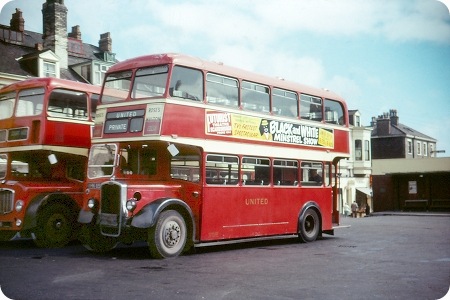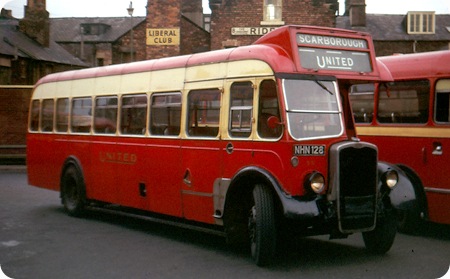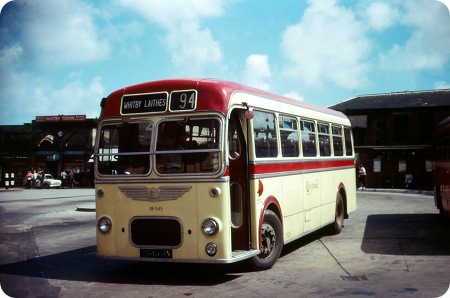
United Automobile Services
1962
Bristol MW6G
ECW DP41F
Previous shots of United Automobile single deck vehicles on this site have been bus bodied or coach bodied, here we have a dual purpose bodied MW6G. United as like many other of the tilling group had a different livery for each type of vehicle body. United’s dual purpose vehicles livery was a reversal of there bus livery of ‘red and cream’ and there coach livery was ‘cream and sage green’. There are links at the foot of this copy to see shots of a bus and coach livery. If you want to know the full specification for the MW6G you can look it up on the Bristol abbreviations here.
The above photograph was taken at Whitby bus station July 1965 and this bus is not exactly on a long distance run as Whitby Laithes I think is around the Hawsker area which is only 3-4 miles south of Whitby. On saying that though what a lovely run on the North Yorkshire Moors with the North Sea just to the side of you, not sure if this route includes calling at Robin Hoods Bay or not. If you know please leave a comment.
Quick links to see the ‘bus’ and ‘coach’ liveries.
Whitby Laithes is just outside Whitby near Stainsacre and before you get to Hawsker. I believe there was and maybe still is a caravan site there.
Fantastic picture I would like to see some Durham District (which was part of United) photos if you have any. How well the colour suits the MW. This vehicle probably used to go on longer express services in its time to London etc.
Paul
Silly little anecdote concerning United and the Whitby area. I studied at the Royal Northern College of Music and the father of one of my tutors was a United inspector in the the Whitby area. Pre RE, all Bristols had manual, many crash, gearboxes. At the top of the road to Robin Hoods Bay, at that time open to traffic, was a sign telling bus drivers to stop and engage first gear. The breaking effect of an epicyclic gearbox is not the same as a manual. The poor driver of the first semi-auto RE to go down this road found this out to his cost. He panicked and threw the thing into reverse. The result was the vehicle seized up and when the fitters unscrewed the gearbox housing, a pile of dust fell to the floor.
David Oldfield
The very steep hill from the main road to Whitby into Fylingthorpe is still used by Uniteds successor Arriva for their 96 Scarborough Whitby Middlesbrough service. For many years it boasted signs at the top and bottom instructing drivers to engage low gear. Halfway up the hill is a hairpin bend which really sorted out the men from the boys! Following an Olympian up the hill was a fairly hair raising business Nowadays the route is worked by single deckers. A similar steep hill Blue Bank just outside Sleights also used to boast signs instructing United drivers to stop and engage low gear Indeed so steep is this road it boasts a sand filled run off for the use of out of control vehicles
Chris Hough
I seem to remember there is sand run off road at the bottom of Garrowby Hill on the York to Bridlington road.
Peter
There is one on the A59 Harrogate to Skipton road after the long decent to Bolton Abbey
Spencer
19/03/11 – 07:48
Can anyone tell me the colour scheme for a Leyland Lion operated by United Automobile in the Bishop Aukland area in the 1912/1920 era.
Brian
19/03/11 – 10:33
Peter is quite right, and the escape lane still exists at the lower end of Garrowby Hill. I once had the most unpleasant but essential task of reporting an East Yorkshire driver who, in a filthy temper all the way from Bridlington Bus Station, carried our full load in a Leyland Leopard down Garrowby Hill in top gear. As I have a very wide experience of driving Leopards I was aware of their tendency to brake fade under heavy usage and this man was very lucky indeed not to have caused a disaster. As would be expected the highly respected EYMS were very concerned and thanked me for the information – not being of a vindictive nature I hope that the man was only reprimanded but the atrocious incident could not possibly go unreported. In one of those contrasts which occur from time to time I had travelled to Bridlington that weekend on a West Yorkshire vehicle (joint services 44/45) which was driven so impeccably that I also wrote to WYRCC with a commendation – soon afterwards that driver was seen in an Inspector’s hat in Leeds !!
Chris Youhill
19/03/11 – 17:20
Chris, we have so much in common. I have this thing about criticism outweighing commendation and that the good should also and always be remarked upon.
To his own surprise, I wrote a letter of commendation about a First driver in Sheffield one Christmas Eve, a few years back. The standard of his driving and his interaction with passengers (yes, not customers!!!) was superb. I also got a very nice reply from management thanking me for taking the trouble. I think this is so important.
David Oldfield
19/11/11 – 10:07
I Googled "uas colour schemes" because I’m modelling Morpeth station 1950s and needed to check something. What do I find? An old friend from my college days.
I did two summer vacs as a conductor at Whitby depot in 1961 and 1962 and if that isn’t one of the coaches we used on the Leeds run then it’s their twin brother.
There wasn’t a service to Whitby Laithes then. The closest would have been the 93 (I think) to Robin Hoods Bay.
Clippie
20/11/11 – 07:35
The mention of Blue Bank reminds me that when I drove for J. J. Longstaff of Mirfield I was half way up with my Bedford VAS/Plaxton when the fan belt snapped. I was very fortunate to be able to back in to a field and then coast down to Sleights to wait to be rescued.
Philip Carlton
12/12/11 – 08:28
Chris Hough refers to advisory/warning signs erected around Whitby on approaches to very steep hills. There is still one such sign at the top of Blue Bank on the approach to Sleights just outside Whitby.
I have attached two photos which please use if you wish.
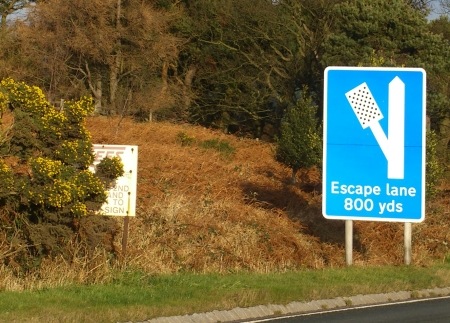
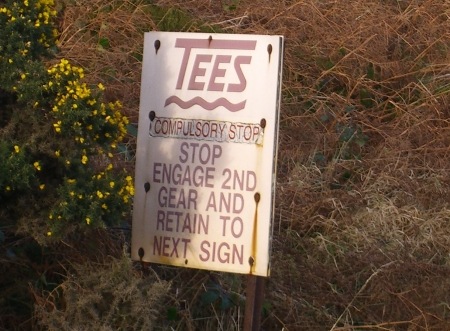
Whilst not the original, it serves the same purpose – it is in fact headed up as ‘TEES’, this company being the eventual successor to United in 1990 prior to the subsequent takeover by Arriva.
The present sign is well obscured by a gorse bush but quite visible to the enthusiast. There used also to be signs at the bottom of the hills with the message ‘United – All clear’, but there is none at the foot of Blue Bank now.
As far as I know, there are no longer any signs on Lythe Bank above Sandsend and I do not know if any signs still exist at Fylingthorpe but would think it unlikely.
John Darwent
13/12/11 – 10:55
Apart from a few odd balls that were presumably acquired as a result of takeovers, up to the formation of National Bus Company the vast majority of United’s bus and coach fleet was made up of ECW bodied Bristol’s. However, for quite some time Whitley Bay Depot had a none ECW Guy Arab, does anyone know how it came to be there?
Ronnie Hoye
13/12/11 – 11:22
Ronnie, I believe it was a Willowbrook body – possibly a rebody of a war-time model. This would almost certainly be as a result of the takeover of an independent. I believe Durham and District was set up to run independents taken over in the area by United – but Whitley Bay would be far too north to be included.
David Oldfield
13/12/11 – 15:19
I am a regular reader but have not contributed previously.
Re the recent posts concerning the warning signs on Blue Bank there is a beautifully restored United Red “Engage Low Gear” sign at the foot of Ruswarp Bank in Ruswarp Village near Whitby. There is quite a few photos to be seen if you Google – “United Ruswarp Compulsory”
On Lythe Bank there was an intermediate sign in both directions at the Lodge gates and I recall that for climbing vehicles it read “Drivers may build up gears” or something similar. In the down direction the first sign was for 2nd gear and the intermediate prior to the steepest 1 in 4 portion was for 1st gear.
I recall others on the approach to Goathland.
Farmer G
15/12/11 – 15:41
Excellent – thank you for the link Farmer G
John Darwent
14/01/12 – 16:19
The United 1962 Bristol MW6G ECW DP41F is my colour scheme. I worked at Grange Road 1954 – 1958/9 in the drawing office. The drawings came in and we had to colour them in. The CE chose mine….
Yes Durham and District Services was set-up to run the independents United had taken over. In my time in the pump house in Central Works we had Bob I think it was who’d come in from the company at Hurworth that United/DDS had taken over.
In the drawing office there was drawings of the "stop and engage low gear" signs.
Mike Hingley
04/05/12 – 08:59
Could anyone tell me please the location of United’s Scarborough depot? Is the building still there?
Goff
04/05/12 – 14:45
The Depot is still there and is now a Car Parking facility rejoicing in the name of the "Palm Court" on Vernon Road near the junction with Falconers Road. It appears to be connected to the up-market Palm Court Hotel. It is clearly shown on Google Earth.
Gordon Green
04/07/13 – 17:35
I seem to recall a double decker bus service in the 1950’s to Castle Park in Whitby, route number 96 when I was about 5 or 6. Does anyone remember this? I seem to remember that the bus went up Chub Hill, along Upgang Lane and Love Lane before heading past White Leys estate.
Mic
20/08/13 – 18:53
A K5G from Scarborough depot was loaned to Whitby Depot for the summer period in the fifties. The service was numbered 98 and ran from the Bus Station to Castle Park via Chubb Hill, John Street, Promenade, Argyle Road, White Point, Love Lane and Stakesby Road. The Destination blind permanently showed "Castle Park", and the lower blind "White Point The Spa 98. Around 1960 this service was linked with the 99 from the Bus Station to St. Peter’s Road, formerly operated by Heather Motor Services. The resulting cross town service was numbered 96, and was operated by two single-deckers, at first LS5G’s, later MW’s. By the early seventies, Whitby Depot had a single RESL6G, 2862, which was used on the 96 day after day, usually in partnership with an LH; I once overheard a driver stating that Whitby’s manager had tried to get a second RE but had been refused.
Don McKeown
21/08/13 – 06:55
Seeing the earlier post of signs on Blue Bank has got me worried. If the gorse bush has been cut back to reveal the TEES sign saying ‘Stop, Engage 2nd gear Retain to next sign’ and the All Clear sign at the bottom has been removed, what is happening out on the road ?
Are there dozens of buses winding their way around North Yorkshire in 2nd gear looking in vain for the All Clear sign ?
I sincerely hope not!
Petras409
25/08/13 – 06:33
In Don McK’s posting, he mentions Heather Motor Services at Whitby. I recall that on holiday as a very small boy in the late 40’S, I saw what may well have been a Bedford OB or similar in cream with red lining belonging to Moordale Coaches maybe. I have never been able to find a reference to this firm or where they ran from. Don, do you have any information please? Heather MS is well documented though.
John Darwent
29/08/13 – 06:29
Sorry John, I have no recollection of Moordale coaches in the Whitby area, although I have heard the name; was it a company further north, perhaps in County Durham?
Farmer G mentions the restored sign at Ruswarp; this is not strictly accurate, the "United" fleetname at the head of the board has a large U and D, with the NITE smaller and underlined. In reality, only the U was in the larger print with five letters underlined. Further on along the 91 (Malton route) there were a fourth set of gearchanging signs at the "Devil’s Elbow", between the Saltergate Inn and the Hole of Horcum.
Service 94 to Whitby Laithes was a summer only service which survived into the late sixties. It was taken over from Heather Motor Services, along with the 99 St. Peters Road) and 93 (Fylingthorpe)on 29th March 1953. The story of Heather is told in a book by Philip Battersby, published by United Enthusiasts Club in 2005.
Don McKeown
29/08/13 – 06:31
Ah – distant memories of what were my first ever seaside Summer Holidays spent in Whitby. Obviously I’m not the only one on this site to spend holidays there in the late 40’s and early 50’s. On the second and third of those holidays we stayed at the Oxford Hotel opposite the Spa and the highlight for me was the regular passage of the Castle Park bus.
Isn’t it funny how the ‘old’ registration numbers stick in your mind and here is one – CHN 105 passing by on a regular basis all day. For years I recalled it as a K5G with a modern post war body but it was only when I found a copy of the Prestige book on United that I found a photo by G H F Atkins of its sister CHN 106 and discovered that it was not what it first seemed to be. In fact it was a GO5G originally fitted with an odd ball ECW body (14 ft 3in height) but with a lowbridge layout. They were rebodied in 1949 with standard ECW lowbridge bodies which had to be modified to fit the GO5G chassis.
Could the cream/red Bedford OB have been one of Howards’s Tours who used to load in front of the Esplanade Gardens for their excursions ??
Gordon Green
03/09/13 – 16:30
Gordon, I have looked at an image of a Howards’ OB and the colours suggest you may well be correct with your suggestion.I cannot remember whether Howards had any stage services but seem to think that the "phantom" Moordale /Moorsholm /Moorview or whatever Coaches served the Esk Valley area such as Danby and Lealholm. Possibly an ex-Howards OB retaining the paint scheme but with new owner – who knows?
John Darwent
16/09/13 – 06:31
I’ve just noticed Ronnie’s query from December 2011 (!) about a non-ECW Guy ‘decker at Whitley Bay. David is quite right in attributing it to the formation of DDS. It was GGH1 (GHN 69), a Guy Arab III which had been ordered by Darlington Triumph, one of the constituent companies – along with ABC and Express – of DDS. Its chassis was delivered to DDS in May 1951 and originally intended to operate for them, but was actually ‘transferred’ to United who had it bodied by Willowbrook as a highbridge 58-seater. It entered service in June 1952 at Carlisle depot but, later, found its way to Whitley Bay where it was often to be found on the 5 and 17 services and where, I believe, it ended its days.
Alan R Hall
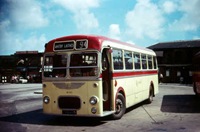 Vehicle reminder shot for this posting
Vehicle reminder shot for this posting
28/05/14 – 07:46
Regarding the question by John Darwent and others above. Moordale Bus services Ltd who ran in the Whitby area. The company was actually based in Newcastle and survived in various forms until takeover by British Bus in the 1990s. They also had a garage at Danby and ran;
Loftus-Liverton Mines-Liverton Village-Moorsholm, Castleton-Danby-Lealholm-Ugthorpe-Sandsend-Whitby, Loftus-Liverton-Danby-Lealholm-Glaisdale,
Danby-Fryup Dale (Sats only)
Even in the the post-war traffic boom these must have been marginal and the whole operation was abandoned in 1954. Just Loftus-Liverton was replaced, by Saltburn Motor Services, and even then I believe there was a gap before this started.
Phil Drake
28/05/14 – 16:03
Thanks for that Phil. Very enlightening.
John Darwent
07/06/14 – 08:24
I have been in the Whitby area this week and have found another of the old (but badged ‘Tees’) ‘compulsory stop engage 1st gear’ signs at the foot of Saltersgate Bank on the A169 Whitby Pickering road. This is opposite the sadly closed Saltersgate Inn where the peat fire was aid to have been burning for nearly 300 years. There used to be one at the top for descending vehicles but I could not see this as I drove past.
I wonder if Yorkshire Coastliner observe the spirit of the old signs ?
Gordon Green
